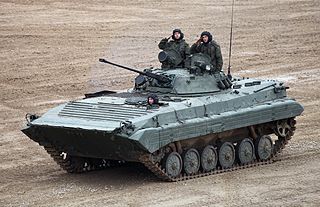
The BMP-2 is an amphibious infantry fighting vehicle introduced in the 1980s in the Soviet Union, following on from the BMP-1 of the 1960s.

The Véhicule de l'Avant Blindé or VAB is a French armoured personnel carrier and support vehicle designed and manufactured by Renault Trucks Defense. It entered French service in 1979 and around 5,000 were produced for the French Army as well as for export. It has seen combat in various conflicts in Africa, Asia as well as Europe and has also been exported to more than 15 countries.

The Bionix (BX) is a family of tracked Singaporean armoured fighting vehicles developed by ST Kinetics. Intended to augment the Singapore Army's aging M113 armoured personnel carriers, it is the first indigenous armoured vehicle to be developed in Southeast Asia. The Bionix has been operational with the Singapore Armed Forces (SAF) since 1999 in a wide variety of adaptations including the Bionix II, Bionix 25 and Bionix 40/50 variants.

The M-84 is a Yugoslav main battle tank, a variant of the Soviet T-72 tank. The M-84 is still in service in Croatia, Serbia, Bosnia and Herzegovina, Slovenia and Kuwait.
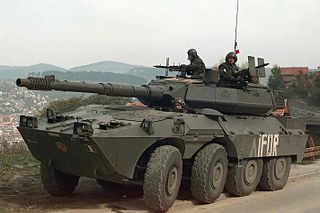
The Centauro is a family of Italian military vehicles originating from a wheeled tank destroyer for light to medium territorial defense and tactical reconnaissance. It was developed by a consortium of manufacturers, the Società Consortile Iveco Fiat - OTO Melara (CIO). Iveco Fiat was tasked with developing the hull and propulsion systems while Oto Melara was responsible for developing the turrets and weapon systems.

The SK-105 Kürassier is an Austrian light tank armed with a rifled 105 mm gun in an oscillating turret. It is estimated that over 700 have been produced, with initial deliveries in 1971. It shares its CN 105-57 main gun with the French AMX-13, which was widely produced and deployed.
A huge number of M113 Armored Personnel Carrier variants have been created, ranging from infantry carriers to nuclear missile carriers. The M113 armored personnel carrier has become one of the most prolific armored vehicles of the second half of the 20th century, and continues to serve with armies around the world in many roles.

A Remote Controlled Weapon Station (RCWS), or Remotely Operated Weapon System (ROWS), also known as a Remote Weapon System (RWS), is a remotely operated weaponized system often equipped with fire-control system for light and medium-caliber weapons which can be installed on a ground combat vehicle or sea- and air-based combat platforms.

VIU-55 Munja is a combat engineering vehicle produced by Serbia. VTI did the conceptual design of the Munja general-purpose engineer vehicle and the Technical Overhauling Institute "Čačak" built the vehicle. The main idea was converting the T-55 tank, using its main structure and subsystems and adding new components, equipment and devices to create a vehicle for entirely different purposes. Good terrain negotiating ability and ballistic protection of T-55 tank were retained, while engineer equipment and armament were refitted. Starting in 2004, about 210 of these vehicles were produced. It was the first armoured vehicle for the Serbian engineer corps, outfitted with special purpose engineer equipment and a respectable armament belonging to the most modern designs of this kind.

The WZ-551 is a Chinese wheeled infantry fighting vehicle family. The name WZ-551 actually covers two families of vehicles with the official designations in the People's Liberation Army (PLA) – Type 90 and Type 92. Over 3,000 WZ-551s are in service with the PLA, where they are used by medium mechanized infantry units.

The Dragoon 300 AFV was produced by Arrowpointe Corporation during the 1980s. It was based on the automotive components of the United States Army's M113 APCs and 5-ton trucks. It resembles a larger V-150 Commando.
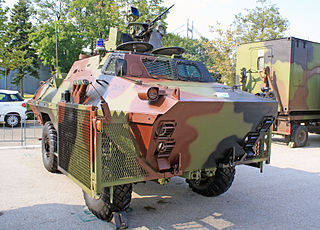
The BOV, is an all-wheel drive armoured vehicle manufactured in the former Yugoslavia and today in Serbia. The second generation BOV is currently in development.
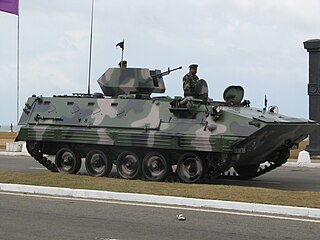
The Norinco Type 89 tracked armoured fighting vehicle is a Chinese armoured personnel carrier. It was developed from the earlier export market Type 85 AFV vehicle. It entered service in the late 1990s and was first shown publicly in 1999. There are approximately 1,000 in service. It has the industrial index of WZ534 and although it was mainly developed for the PLA, there is also an export version YW534.

MLVM is a Romanian armoured personnel carrier. The vehicle was designed and used as an infantry fighting vehicle for the vânători de munte of the Romanian Army, though technically it is a tracked armoured personnel carrier according to UN classification because of its light armor and armament.

The Type 85 is a tracked armoured fighting vehicle produced by Chinese company Norinco. It is an improved version of the Type 63 armoured personnel carrier. The vehicle is bigger, has additional firing ports and periscopes, a longer chassis with an additional road wheel on each side, and is equipped with an NBC protection system.

The Type 90 is an armoured fighting vehicle produced by Chinese company Norinco; it is the successor for the Type 85 AFV of which it uses some components. The Type 90 series was developed for export, and consists of at least 10 different types; its industrial index is YW535.

The OF-40 is an Italian main battle tank developed as a joint venture between OTO Melara and Fiat, and intended primarily for export sales. OTO Melara would develop and produce the hulls, and automotive components would be provided by Fiat. Initial design work was started by OTO Melara in 1977, with the first prototypes ready by 1980.
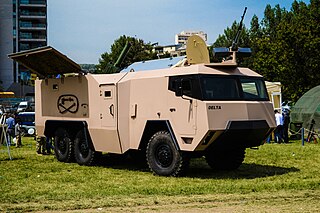
The GMM-120 self-propelled mortar is a proposed armoured mortar carrier concept with a 120 mm automated mortar station. The system is being developed by STC Delta.
The Vickers Main Battle Tank Mk. 4 later known as the Vickers Valiant was a main battle tank developed as a private venture by British company Vickers for export. Its development began in 1976 and ended in January 1984. Although the Valiant did not enter production, its development provided valuable experience in the production of an aluminium-hulled, Chobham-armoured tank in the 40 tonnes weight range. A further development of its turret was later used for the Vickers Mk. 7 MBT.


















